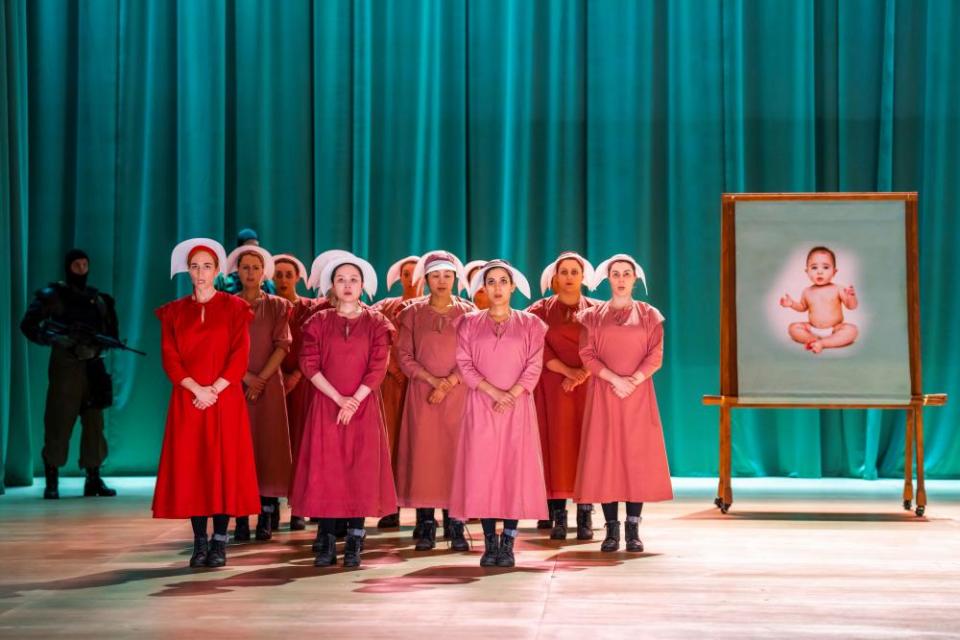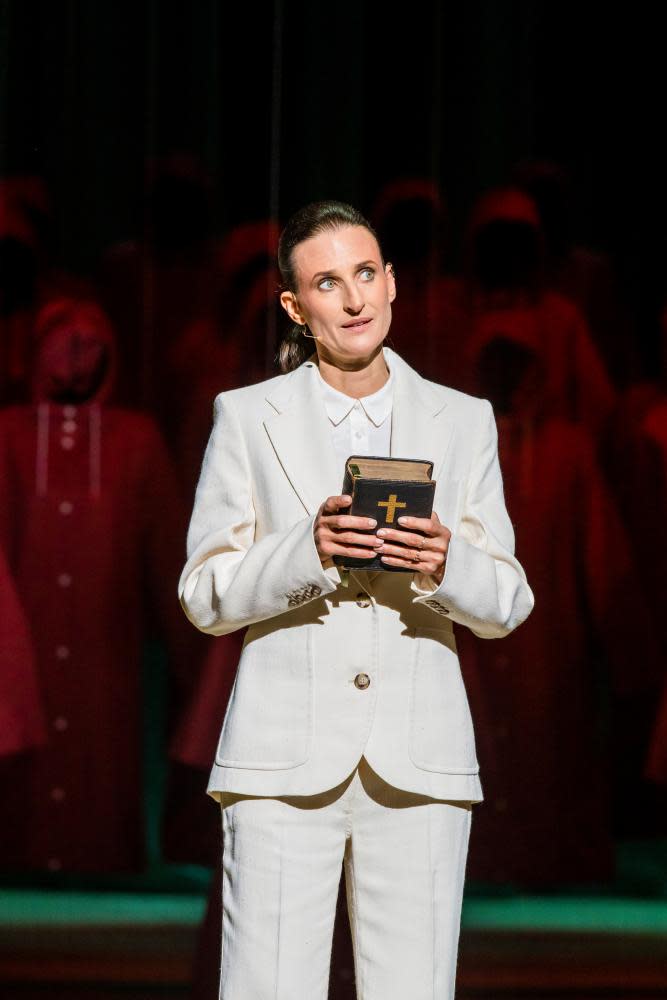The week in classical: The Handmaid’s Tale; Le Chemin de la Croix; Bournemouth SO/Karabits

We think of a dystopia as an imaginary place in the future. When Margaret Atwood wrote The Handmaid’s Tale in 1985, she said everything in the novel had already happened: Iran, China, Romania. Today she might have said Afghanistan, where musicians have been forced to parade with their instruments tied around their necks. Or Palm Beach, where Jeffrey Epstein’s sex-trafficking rituals resemble treatment meted out to the young women in Atwood’s Gilead. Or, in any respect, daily, hourly, events in Ukraine.
The Danish composer Poul Ruders (b1949) understood the novel’s resonance early. His 2000 opera, with a libretto by Paul Bentley, was given its UK premiere at English National Opera in 2003. Streamlined (to a degree) and reworked, it is now back at the London Coliseum, the directorial debut choice of Annilese Miskimmon, ENO’s artistic director. Joana Carneiro, assured and precise, conducts an exemplary performance. Stylish, unfussy designs are by Annemarie Woods, with Paule Constable’s lighting.
Last time, despite moments of brilliance in Phyllida Lloyd’s production, The Handmaid’s Tale was a dour, noisy and crushing affair. Those – I include myself – who struggled with the book found the opera equally unapproachable. Relationships between leading characters, normally the heart of opera, felt robotic and remote. Much in this new version has improved, even if some of the work’s raw guts has been lost in the process. The story is clearer, helped by surtitles (not yet in use in 2003) – a reflection on the complexities of the narrative, not on any inadequate diction.
There’s a fine line between art that shakes us to the core and art that leaves us depressed
Ruders’s detailed orchestral colours are never dull, swerving from the sweet tonality of Amazing Grace (quoted in the score) to aggressive dissonance, enhanced by a battery or instruments from harpsichord and piano to xylophone, bells, gongs, woodblocks, unidentifiable grindings and sizzlings and the insistent ambush of a large bass drum. Every aspect of the singing and production is impressive, fluently staged with a backdrop of drapes and a few mobile set pieces such as The Wall. The women of English National Opera’s chorus have many opportunities to shine, and do. The hardworking ENO orchestra excels.

In the central role of Offred, the formidable Kate Lindsey, affecting both as versatile singer and actor, gives a committed performance. Her almost constant presence on stage gives focus and heart, especially in her delicate, soft singing, accompanied by solo harp. Emma Bell’s compelling but thanklessly high-pitched Aunt Lydia, Avery Amereau’s superbly creepy Serena Joy, with Susan Bickley, Rhian Lois, Pumeza Matshikiza, Elin Pritchard and more, lead a strong ensemble. Robert Hayward makes a powerful and sinister Commander, with the tenor Frederick Ballentine charming as his equivocal sidekick Nick. Camille Cottin (of Call My Agent!), as the professor leading the symposium that frames the action, is an attractive if puzzling bonus.
Ruders has said the novel’s impact hit him gradually, like “a slow, painful strangulation”. This mood translates to the experience of watching it. We care, unquestionably, intellectually, about the totalitarian horrors depicted, but the individuals remain elusive, their true selves glimpsed only in shadowy flashback. That toxic pummelling of humankind, reduced to facelessness, may be the point. There’s a fine line, however, between art that shakes us to the core and shows us the pity of suffering, and art that leaves us depressed and gloomy. For me, despite best efforts, The Handmaid’s Tale, as book, TV, opera, falls into the second category. Optimism, and plenty of it, came nonetheless in the quality of work on show here, proof that ENO is on an up, even if I left on a down.
The seven-day Easter festival at St John’s Smith Square, which ends tomorrow afternoon, usually includes at least one unappreciated novelty. This year the rosette must go to Marcel Dupré’s Le Chemin de la Croix (1931), a sequence for organ on the 14 stations of the cross, performed by Martin Baker. Dupré (1886-1971) was a teacher of Olivier Messiaen. It’s a reason to seek his music out, a mainstay for organists but not for the rest of us. You hear the seeds of ideas and structures that Messiaen pushed to bolder horizons. Capable of much that is stirring and eerily mystical, Dupré has his moments: the 11th station, Jesus Is Nailed on the Cross, invites the organist to attack the instrument with obsessive hammer blows, which Baker did emphatically, followed by fragmented, hushed music of consolation. While it helped that Baker announced each station to guide us through, the meditative flow was interrupted: sometimes a cloud of unknowing is the better option.
Under the guidance of its Kyiv-born chief conductor, Kirill Karabits, Bournemouth Symphony Orchestra has introduced music from former Soviet states in its ongoing Voices from the East series. The latest concert from Lighthouse, Poole, still available online (£10), featured a world premiere by Franghiz Ali-Zadeh, from Azerbaijan. NIZAMI Cosmology, colourful and expansive, giving voice to many solo instruments, celebrates the 12th-century Persian poet-astronomer Nizami. He observed the movement of celestial bodies and tried, as well he might, to explain how the size and brightness or stars and comets influenced life on earth. Ali-Zadeh, 75 next month, was there to take her bow. The response from the Dorset audience, towards musicians, conductor, composer, was heartfelt: a reminder, if ever it was needed, of music’s own cosmic power to connect.
Star ratings (out of five)
The Handmaid’s Tale ★★★
Le Chemin de la Croix ★★★
Bournemouth SO/Karabits ★★★★
Bournemouth Symphony Orchestra’s Voices from the East: Karayev, Ali-Zadeh and Shostakovich is available to watch online until 6 May

 Yahoo News
Yahoo News 